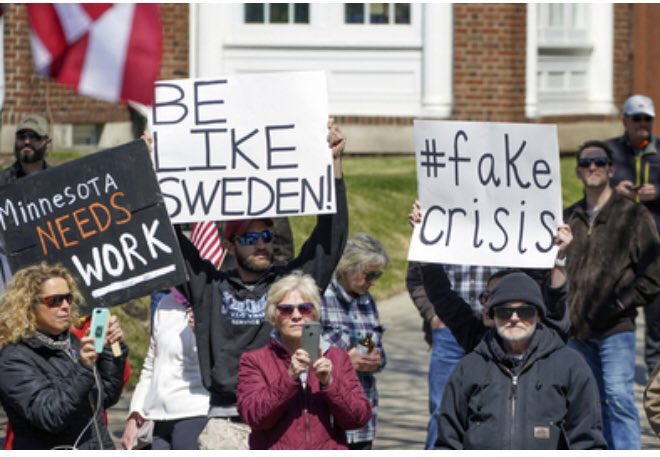
The State of our State is strong.
The State of our State is resilient.
The State of our State is united.
These lines were delivered by Minnesota Governor Tim Walz while addressing his residents on April 5. Despite a scattered federal response to the coronavirus, Minnesota’s state response was coherent and united, and Walz’s statement not only seemed true—it was true.
A fast-forward to April 17 reveals a much different story. In an echo of demonstrations in multiple other state capitals, hundreds of demonstrators gathered outside Walz’s residence in St. Paul to protest his stay-at-home order. Minnesota’s unity was showing cracks and the professed strength and resiliency of its residents were reaching a breaking point.
Why is there suddenly anger? What is the source of it? Boredom? Is there nothing left for kids to binge-watch (or parents to binge-drink)? Not for most. Motives of protesters have been well circulated and best distilled into two sentiments—economic wariness and political suspicion.
When governors effectively began to shut down their state economies in March, many Americans found themselves in frightening new territory. Some restaurants sought partial hope in take-out orders but all retailers, including small shops, had to shut down, depriving both owners and workers of their income and their trade.
Others found themselves in an unemployed grey area between essential workers who had to show up and white-collar employees who could work from home. Residents of unaffected rural towns suddenly found their livelihoods shattered by restrictions that they thought were only necessary for metro populations.
For some, predictions that coronavirus could hit rural America hard had to be seen to be believed.
Many understood the importance of the stay-at-home orders when they were instated. At that point, these orders were set to expire in late April. Despite a month of hardship, there was a definite light at the end of the tunnel; there weren’t any protests because there was a degree of certainty about a return to normality.
This all changed when states realized the long haul the country was in for and extended their stay-at-home orders accordingly. Michigan moved its end date to April 30, then again to May 15. Walz moved Minnesota’s back as well, taking a gamble on the strength and resilience of his constituents. With the return to normality postponed, anger swelled.
The week the protests began, President Donald Trump called on followers to liberate Minnesota, Michigan and Virginia as if they were the beaches of Normandy. The intent of his message is not hard to figure out. All three states have Democratic governors and are a potential battleground for next fall’s election.
More protests began to appear across the country, and on April 26 the White House announced that social distancing will have to occur at some level into the summer, effectively killing the hope of a resurgence for small businesses that rely on seasonal summer tourists.
When people can’t provide for their families beyond unemployment, they get angry. When shop owners can’t practice their livelihoods and sell their craft, they get angry. Even an understanding of epidemiology can only go so far as a counter to the primal drive for financial and personal fulfillment.
Are the economically wary justified for feeling the way they do? Absolutely, and I would be speaking from a peak of blind privilege if I said that they shouldn’t.
Do these feelings justify joining protests where social distancing is ignored and the hard facts of science are slipped under the rug? Absolutely not.
My message is this: Opening up shop may be good for you and your workers in the short term, but it is bad for everyone in the long term.
Those in small towns skeptical of statewide regulations should take note of the COVID-19 clusters in South Dakota, a low-density state that has seen some of the highest per-capita cases in the country.
Realistically, choosing to keep a state closed or open is a lose-lose scenario, but by staying closed you lose far less.
It is not unusual or ignorant for someone to be skeptical of the models that recommend these tough policies, but I would urge those that are skeptical to remember that although following the advice of models is imperfect, it is far better than any alternative.
Not all protestors are driven by economic fear, but rather by deep skepticism with a government that can impose a stay-at-home order, even if that order is backed by experts. I would remind protestors with this sentiment of political suspicion that such orders are not necessarily unprecedented.
Multiple U.S. cities had similar restrictions to protect public health during the 1918 Flu Pandemic. Additionally, state and federal leaders have restricted public life at various other times of crisis in American history, sometimes for good and admittedly sometimes for wrong.
If you’re wary of following guidelines because your governor tells you to, follow them because your neighbors need you to. Keep in mind that although protesting is a right, marching without social distancing will ensure that the consequences will spread beyond you.
At any rate, my overall thoughts on these protests continue to dive from bad to worse. In a rewind to the days when the Koch Brothers funded Tea Party rallies, prominent gun groups and conservative political organizations have pumped resources and organizing tools into “astroturfing” demonstrations The intent is to make demonstrations seem “grassroots” from afar, while a close look reveals that the roots are as real as the astroturf that makes up Klein Field at Manitou.
Protestors must not allow themselves to be guided by inflammatory tweets or shadowy political groups. Division within our society as we fight a common enemy will only lead to our failure. America must be strong, resilient and united.
Ian Baxter ’22 is from Hopkins, MN. His major is economics.

